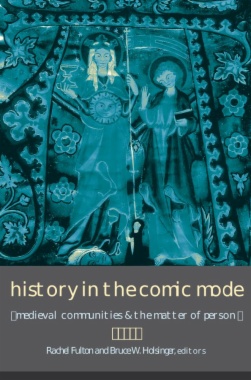In this groundbreaking collection, twenty-one prominent medievalists discuss continuity and change in ideas of personhood and community and argue for the viability of the comic mode in the study and recovery of history. These scholars approach their sources not from a particular ideological viewpoint but with an understanding that all topics, questions, and explanations are viable. They draw on a variety of sources in Latin, Arabic, French, German, Middle English, and more, and employ a range of theories and methodologies, always keeping in mind that environments are inseparable from the making of the people who inhabit them and that these people are in part constituted by and understood in terms of their communities.
Essays feature close readings of both familiar and lesser known materials, offering provocative interpretations of John of Rupescissa's alchemy; the relationship between the living and the saintly dead in Bernard of Clairvaux's sermons; the nomenclature of heresy in the early eleventh century; the apocalyptic visions of Robert of Uzès; Machiavelli's De principatibus; the role of "demotic religiosity" in economic development; and the visions of Elizabeth of Schönau. Contributors write as historians of religion, art, literature, culture, and society, approaching their subjects through the particular and the singular rather than through the thematic and the theoretical. Playing with the wild possibilities of the historical fragments at their disposal, the scholars in this collection advance a new and exciting approach to writing medieval history.
- Table of Contents
- List of Illustrations
- Acknowledgments
- Introduction: Medieval Communities and the Matter of Person, by Bruce Holsinger and Rachel Fulton
- Part I. Saints, Visionaries, and the Making of Holy Persons
- 1. Forgetting Hathumoda: The Afterlife of the First Abbess of Gandersheim, by Frederick S. Paxton
- 2. “If one member glories . . .”: Community Between the Living and the Saintly Dead in Bernard of Clairvaux’s Sermons for the Feast of All Saints, by Anna Harrison
- 3. The Pope’s Shrunken Head: The Apocalyptic Visions of Robert of Uzès, by Raymond Clemens
- 4. Thomas of Cantimpré and Female Sanctity, by John Coakley
- 5. The Changing Fortunes of Angela of Foligno, Daughter, Mother, and Wife, by Catherine M. Mooney
- 6. “A Particular Light of Understanding”: Margaret of Cortona, the Franciscans, and a Cortonese Cleric, by Mary Harvey Doyno
- Part II. Community, Cultus, and Society
- 7. Fragments of Devotion: Charters and Canons in Aquitaine, 876–1050, by Anna Trumbore Jones
- 8. Naming Names: The Nomenclature of Heresy in the Early Eleventh Century, by Thomas Head
- 9. Economic Development and Demotic Religiosity, by Richard Landes
- 10. Back-Biting and Self-Promotion: The Work of Merchants of the Cairo Geniza, by Jessica Goldberg
- 11. John of Salisbury and the Civic Utility of Religion, by Mark Silk
- Part III. Cognition, Composition, and Contagion
- 12. Understanding Contagion: The Contaminating Effect of Another’s Sin, by Susan R. Kramer
- 13. Calvin’s Smile, by John Jeffries Martin
- 14. Why All the Fuss About the Mind? A Medievalist’s Perspective on Cognitive Theory, by Anne L. Clark
- 15. Aspects of Blood Piety in a Late-Medieval English Manuscript: London, British Library MS Additional 37049, by Marlene Villalobos Hennessy
- 16. Machiavelli, Trauma, and the Scandal of The Prince: An Essay in Speculative History, by Alison K. Frazier
- Part IV. The Matter of Person
- 17. Low Country Ascetics and Oriental Luxury: Jacques de Vitry, Marie of Oignies, and the Treasures of Oignies, by Sharon Farmer
- 18. Crystalline Wombs and Pregnant Hearts: The Exuberant Bodies of the Katharinenthal Visitation Group, by Jacqueline E. Jung
- 19. Gluttony and the Anthropology of Pain in Dante’s Inferno and Purgatorio, by Manuele Gragnolati
- 20. “Human Heaven”: John of Rupescissa’s Alchemy at the End of the World, by Leah DeVun
- 21. Magic, Bodies, University Masters, and the Invention of the Late Medieval Witch, by Steven P. Marrone
- Afterword: History in the Comic Mode, by Rachel Fulton and Bruce Holsinger
- Notes
- Contributors
- Index

